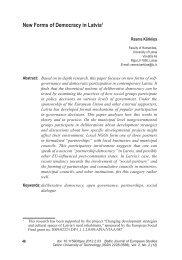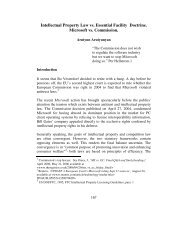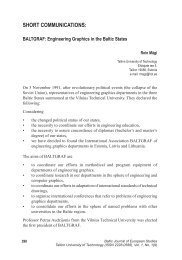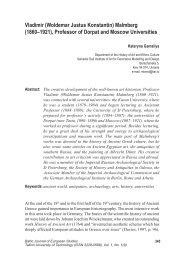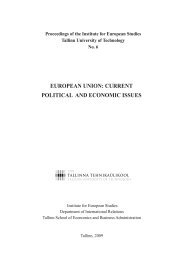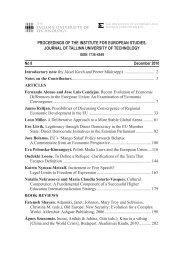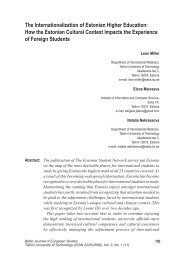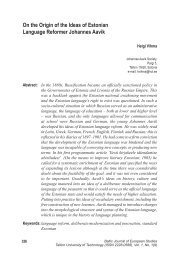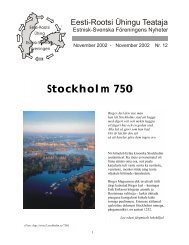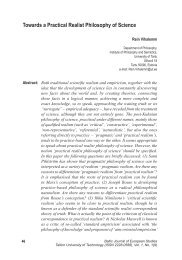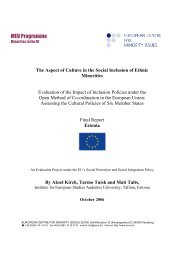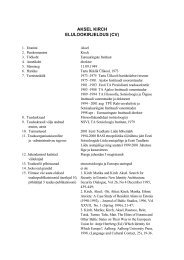Botanical Garden of the university of tartu (dorpat) - The Institute for ...
Botanical Garden of the university of tartu (dorpat) - The Institute for ...
Botanical Garden of the university of tartu (dorpat) - The Institute for ...
You also want an ePaper? Increase the reach of your titles
YUMPU automatically turns print PDFs into web optimized ePapers that Google loves.
Heldur Sander, Toivo Meikar<br />
University <strong>of</strong> Uppsala and defended his doctoral dissertation in 1767. In 1770,<br />
he continued his studies in Paris, Amsterdam and Leiden. In 1772–1778, he<br />
travelled in South Africa and East Asia, working in Japan <strong>for</strong> a prolonged period.<br />
Since 1781, Thunberg worked as a pr<strong>of</strong>essor <strong>of</strong> medicine and natural philosophy<br />
at <strong>the</strong> University <strong>of</strong> Uppsala. Among his most significant scientific works<br />
were overviews <strong>of</strong> South American and Japanese floras. He also collected big<br />
quantities <strong>of</strong> live plants and seeds <strong>for</strong> botanical gardens. Since 1818, Wikström<br />
was <strong>the</strong> director <strong>of</strong> <strong>the</strong> Bergius <strong>Botanical</strong> <strong>Garden</strong>, Stockholm. Thunberg sent 62<br />
accessions in 1823–1825 and Wikström sent 15 accessions in 1823.<br />
In 1839 and 1840, 196 accessions were sent from Munich by <strong>the</strong> botanist Joseph<br />
Gerhard Zuccarini (1797–1848), pr<strong>of</strong>essor <strong>of</strong> botany at <strong>the</strong> University <strong>of</strong><br />
Munich. He commenced medical studies in 1815 at <strong>the</strong> University <strong>of</strong> Erlangen-<br />
Nürnberg, with botanist and nature philosopher Christian Gottfried Nees von<br />
Esenbeck being his teacher <strong>of</strong> natural history. Zuccarini was invited in 1826 to<br />
work as an extraordinary pr<strong>of</strong>essor at <strong>the</strong> University <strong>of</strong> Munich, where he became<br />
a full pr<strong>of</strong>essor <strong>of</strong> agricultural botany and <strong>for</strong>est botany in 1835. In 1836, he also<br />
became <strong>the</strong> curator <strong>of</strong> <strong>the</strong> <strong>Botanical</strong> <strong>Garden</strong> <strong>of</strong> Munich. Zuccarini worked since<br />
1820 on <strong>the</strong> taxonomic treatment <strong>of</strong> <strong>the</strong> Brazilian plant collections <strong>of</strong> Carl Friedrich<br />
Philipp von Martius (above all Cactaceae) as well as <strong>the</strong> plants collected in Japan<br />
by Philipp Franz von Siebold, a German physician and traveller. Zuccarini also<br />
described plants discovered in o<strong>the</strong>r areas, including Mexico. Nees von Esenbeck<br />
(1776–1858) sent 63 accessions from Wrocław in 1847 and 1849.<br />
Summary<br />
Similarly to <strong>the</strong> respective developments elsewhere in Europe, botanical science<br />
had developed to a high level by <strong>the</strong> end <strong>of</strong> <strong>the</strong> 18 th century and <strong>the</strong> first decades <strong>of</strong><br />
<strong>the</strong> 19 th century also in Russia, where <strong>the</strong> development <strong>of</strong> botany was fostered by<br />
links with Carl Linné and his school, academic research toge<strong>the</strong>r with extensive<br />
expeditions, collection <strong>of</strong> plants and exchange <strong>of</strong> seeds, establishment <strong>of</strong> herbaria<br />
and development <strong>of</strong> ornamental gardening and park culture (Trautvetter, 1837,<br />
pp. 4–136; Rowell, 1980, p. 15; Kolchinsky, 2004; Sokol<strong>of</strong>f et al., 2002, pp.<br />
129–191). When <strong>the</strong> <strong>Botanical</strong> <strong>Garden</strong> <strong>of</strong> <strong>the</strong> University <strong>of</strong> Tartu was about<br />
to be established, all preconditions were in place <strong>for</strong> <strong>the</strong> rapid growth <strong>of</strong> its<br />
species richness. This was undoubtedly fostered also by <strong>the</strong> network <strong>of</strong> botanical<br />
researchers <strong>for</strong>med in <strong>the</strong> 18 th century, and by <strong>the</strong> Society <strong>of</strong> Corresponding<br />
Botanists (established in 1815), which involved 70 botanists, pharmacists,<br />
250<br />
Baltic Journal <strong>of</strong> European Studies<br />
Tallinn University <strong>of</strong> Technology (ISSN 2228-0588), Vol. 1, No. 1(9)



